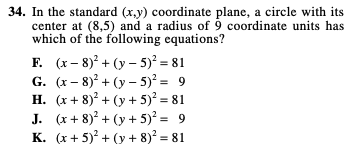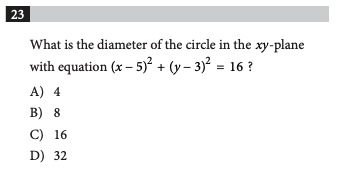
If you’re a high schooler getting ready for the college admissions process, you may be wondering about the differences between ACT and SAT exams. We have updated all of our material to reflect the recent changes to both the Digital SAT and the New, Enhanced ACT in 2025, but now that you have the material needed for preparation, what else is important to know?
Versus the SAT, the ACT generally requires students to know more advanced concepts and work more quickly. Our experience working with thousands of students over the last 18 years is that fewer than 5% of students have significantly different scores on the Digital SAT vs the ACT.
In recent years, both the SAT and the ACT have undergone massive transformations involving number of questions and test timing. Even considering this rework, the ACT and SAT are still incredibly similar and the majority of students will score similarly on the exams. Both the Digital SAT and the new, enhanced ACT test core concepts from Math, English, and Data Analysis. They are both peer-normed tests (you’re scored in comparison to your classmates). The ACT has an optional science and essay section, while the SAT has an essay section that is only available in some states.
This guide to the differences between the ACT and SAT will cover:
- Key differences between the ACT and SAT
- ELA on the SAT vs on the ACT
- Math on the SAT vs on the ACT
- The (Optional) ACT Essay
- How to Prepare for the ACT or SAT
Setting new test-optional policies aside, top colleges like Harvard, Princeton, and Stanford could not care less which test you take (so long as you do well); both the ACT and Digital SAT are nearly universally accepted at US colleges. The ACT and SAT go back and forth between which exam is technically more popular when counted by completed tests; depending on the year, they each test between 1.7 and 2.2 million college-bound juniors.
Should You Take the ACT or the SAT?
Wondering which of the two exams you should prep and sign up for? In our opinion: take them both. When you start to get serious about your ACT/SAT prep—hopefully early in your junior year of high school—start by taking a practice test of both the ACT and the Digital SAT under timed conditions.
Focus your energy on the test that you scored better on—or, in the event you scored equivalently, focus on the test you felt more comfortable with. When it comes time to take an actual ACT or SAT, take them both if your time and budget allow. Preparing for one test will almost equally prepare you for the other. And doing any preparation at all will also likely help you out in core academic classes in school like Math, English, and Science.
ACT vs SAT Comparison—Key Differences
| Key Differences | ACT | SAT | |
| Pacing | The SAT provides 45% more time per question | 2 hours 5 minutes to work 131 questions (57 sec/question) | 2 hours and 14 minutes to work 98 questions (82 sec/question) |
| Math | The ACT includes more advanced concepts | Up to Pre-Calculus | Up to Algebra II |
| Reading & Writing | The ACT has an English section and a Reading section, while the SAT has combined them | 10 long passages throughout ELA sections; English asks about "passage as a whole" | One short passage per question |
| Science & Data Analysis | The ACT has an optional Science test, while the SAT does not | 40-question optional Science test, including experimental design | Science questions mixed among all sections |
| Essay | The ACT has an optional essay, while the SAT does not | Presents points of view and asks students to craft an argument | No essay |
1. Pacing: Digital SAT vs ACT Timing
The SAT provides about 45% more time per question than the ACT. Not including the optional sections, on the ACT, you’ll have just over 2 hours to work 131 questions—on the digital SAT, you’ll have about 2 hours and 15 minutes to work 98 questions.
2. Digital SAT Math vs ACT Math
- The ACT includes more advanced concepts than the SAT.
- The SAT Math test doesn’t get much more difficult than Algebra 2, whereas the ACT includes some advanced concepts from Precalculus.
- The SAT Math test includes some science-related problems—the ACT Math test does not include these questions, because that is the role of the ACT Science test.
3. Digital SAT Reading and Writing vs ACT Reading & English
- The SAT has a combined Reading & English section; the ACT has two separate sections.
- The SAT tests students using one short, paragraph-length passage per question; in contrast (and like how the SAT tested before its digital renovation), the ACT tests students with four full Reading passages and approximately six English passages, each paired with 5-10 questions.
- The SAT Reading test includes a handful of quantitative evidence questions; the ACT Reading test does not include these questions, as that is the role of the ACT Science test.
- Although both test grammar, the ACT tends to have more grammar-related questions and test a greater variety of concepts.
4. Digital SAT Science Questions vs the ACT Science Test
- The SAT scatters some data analysis and science questions throughout all sections of the test, whereas the ACT has an optional 40-question (40-minute) test mostly dedicated toward data analysis in the form of the Science Test.
- The ACT Science test includes experimental design questions where students have to understand how to manipulate variables; the SAT does not have this.
- The ACT Science test will occasionally ask 1 to 2 “outside knowledge” science questions, which expect students to know some basic scientific concepts.
6. ACT Essay vs SAT
The ACT focuses on crafting an argument after being presented different points of views. The SAT no longer has an essay section.
Digital SAT Reading and Writing vs. ACT Reading and English
While the SAT used to each have two distinct ELA sections like the ACT does (Reading and English), they are now combined into one large Reading & Writing section on the Digital SAT. The ELA sections on the two tests have quite different approaches to the question structure, but they test students on roughly the same content areas, covering key topics in reading comprehension and English grammar, style, and editing,
The SAT has an overall maximum score of 1600, and 800 of those possible points come from the first half of the exam, the Reading & Writing section. Around 50% of the questions cover Reading Comprehension topics and the rest cover English/Writing.
The Digital SAT is organized into modules, which allow the test to adapt to student performance. The first half of the Digital SAT’s Reading & Writing test is the standard Module 1 (the same for every student taking the test that day), and each student’s individual performance determines which Module 2 they’ll take. If a student performs poorly on the first module, they are given an “easy” Module 2; if they did well on the first module, they’re given a harder second module. (The same applies for the math section.)
Meanwhile, the ACT presents its English and Reading Tests as two of the three mandatory multiple-choice sections on the exam (the other one being Math). For each multiple-choice section, the student’s raw score is converted into a “Scale Score” from 1 to 36. The average of the student’s scale score from each section results in their overall ACT score, or composite score. So, the English and Reading sections each have equal weight in determining a student’s composite score.
At the end of the day, English and Reading together make up two-thirds of a student’s score on the ACT and only half of their score the Digital SAT. Traditionally, the ACT has been considered more STEM-oriented, but this might change in light of the Science section being optional, and thus not factoring into students’ composite scores.
Still, when it comes to determining which test you’re better-suited for, it’s important to compare the format and content of each one—understanding which test is better aligned with a student’s skillset can help give them an edge when it comes to scoring highly and gaining admission to the college of their choice.
Timing of SAT and ACT ELA Tests
Let’s start with the basics: the length and timing of the SAT and ACT Reading & Writing tests.
| Digital SAT | ACT Reading | ACT English | |
|---|---|---|---|
| Number of Questions | 54 | 36 | 50 |
| Time Allotted | 64 minutes | 40 minutes | 35 minutes |
| Time per Question | 1 minute ~11 seconds | 1 minute ~7 seconds | 42 seconds |
This brings us to our first key takeaway: the ACT’s ELA sections are much longer than the Digital SAT Reading and Writing, both in terms of length and timing. You will only have to spend just over an hour answering 54 English and Reading questions on the SAT; on the ACT, you will spend a total of 75 minutes answering 86 ELA questions (across both sections). The ACT will also require you to test at a quicker pace, allotting less than a minute per ELA question.
Because these are reading tests, you’ll have to read the provided passages and answer their corresponding questions within the time limit for both the ACT and the Digital SAT. That being said, what constitutes as a passage is now different between the two exams. Generally, the ACT has 10 long ELA passages throughout the test (which range between approximately 185-800 words), while the Digital SAT has one very short passage per question, which will never be longer than 150 words.
ACT vs SAT Reading Comprehension
As we dive into what differentiates the Digital SAT’s approach to ELA questions from what you’ll find on the ACT, remember: because the SAT has consolidated its English and Reading sections into one large division of the exam, you’ll be encountering a mix of both Reading Comprehension and English/Writing questions throughout the Digital SAT.
Types of Reading Passages
The ACT Reading section has four passages (the English section has approximately six), while the Digital SAT Reading & English section has 54. Don’t be too bewildered by this—SAT passages now have 150 words or fewer!
Each question in the Digital SAT Reading and Writing section tasks you to read a short passage (or a pair of short passages) and answer a single corresponding question. Meanwhile, on the ACT Reading section, you will read four roughly 800 word-long passages and answer nine questions per passage.
In terms of the types of reading material students will see on the SAT and ACT, the breakdown of passage types is very similar between the two tests, representing the following subject areas:
- Literature
- History/Social Science
- The Humanities
- Natural Science
The ACT has one reading passage per subject while the Digital SAT has at least ten per subject, scattered throughout the exam. As such, students will encounter a mix of literature, humanities, and STEM passages, regardless of which test they take.
Something else to consider is the prose style of the two exams. While the SAT has passages that are from older texts (all of their literary passages are out of copyright, which generally means that they were published at least 100 years ago), these passages are quite short. The ACT, meanwhile, has much more recent passages; in an analysis of three official ACT practice tests, the oldest passage was from 1984, and the bulk of the passages were published in the early 2000’s. Students that are reluctant readers or have trouble concentrating to read longer passages will definitely benefit from the Digital SAT’s short passages, but the ACT’s cohesive nine questions per passage may appeal to others.
Types of Reading Comprehension Topics
A final thing to consider when it comes to the difference between the Digital SAT and ACT Reading sections is looking at the topics of the questions that students are asked. The SAT and ACT are quite similar in this regard.
| Digital SAT Reading Comprehension Topics | |
|---|---|
| Content Domain | What is Tested |
| Information and Ideas | Reading comprehension, analysis, and reasoning skills. Locating and interpreting information and ideas from texts and graphics. |
| Craft and Structure | Vocabulary and analysis skills needed to understand words in context, evaluate texts rhetorically, and make connections between texts. |
| ACT Reading Comprehension Topics | |
|---|---|
| Content Category | What is Tested |
| Key Ideas and Details | Reading comprehension, analysis, and reasoning skills. Locating and interpreting information and ideas. Understanding sequential, comparative, and cause-effect relationships. |
| Craft and Structure | Vocabulary and analysis skills. The ability to evaluate texts rhetorically, understand points of view, and interpret authorial decisions. |
| Integration of Knowledge and Ideas | The ability to understand authors' claims, distinguish between opinions and facts, and make connections between texts. |
As you can see, despite the differences in how the two exams categorize the topics they cover and the way they present passages, the content tested on both exams are similar.
The main aspects that differs is a key question type on the Digital SAT’s reading test that requires students to analyze quantitative information (that is, graphs, tables, and charts)—this is one of the ways that the SAT integrates science questions. In contrast, quantitative information doesn’t show up on the ACT’s Reading Test—largely because the ACT tests students’ data analysis skills through the Science section, which the SAT does not have an equivalent for.
ACT vs Digital SAT English
The differences between the reading questions on the Digital SAT and ACT are similar to the differences between the way each exam tests grammar, style, and editing. The ACT’s English Test presents students with a series of passages, each of which is paired with a set of questions that refer to particular words, phrases, sentences, or paragraphs within the text. Because the Digital SAT’s ELA section is a mix of both Reading and English topics, its English questions follow the same format as the Reading questions: a brief, <150 word passage (which could be about literature, history/social science, science, or the humanities) followed by a multiple choice question.
Types of English Questions
On both the SAT and ACT, English/Writing questions test students’ punctuation, grammar, and overall editing abilities. While you will tackle longer passages on the ACT and spend time editing their writing through several questions, the Digital SAT English questions tackle a single editing topic with each passage.
| Digital SAT English Topics | |
|---|---|
| Content Domain | What is Tested |
| Expression of Ideas | The ability to revise texts to improve their effectiveness/meet specific goals. (ex. transitions, rhetorical synthesis.) |
| Standard English Conventions | The ability to edit text to fit Standard English Conventions. (ex. Punctuation, grammar agreement.) |
| ACT English Topics | |
|---|---|
| Content Category | What is Tested |
| Production of Writing | The ability to understand the purpose of a text, how to develop topics, and how to structure/organize a work of writing. |
| Knowledge of Language | Language skills. The ability to use precise word choice and maintain a consistent tone. |
| Conventions of Standard English | The ability to understand and apply the conventions of standard English grammar (ex. Sentence structure, punctuation, grammar usage and agreement.) |
As you can see the ACT and the Digital SAT are very similar in which English topics they tackle. Both exams will ask you to:
- Select the grammatically correct revision to a text.
- Ensure a precise flow between ideas.
- Understand the correct punctuation to use in different situations.
- Develop topics in order to achieve a particular purpose.
The Digital SAT mainly uses “fill in the blank” style questions where you will select which answer choice fits in the passage correctly, while the ACT will highlight text in the passage and ask which revisions to make, as seen in the example questions below (pulled from the 2021-2022 “Preparing for the ACT Test” (form 2176CPRE) and from Module 2 of the Official SAT Practice Test #1). The SAT’s approach can be considered more “straight to the point” with less ambiguity than the ACT’s ever-present “No Change” answer choice.
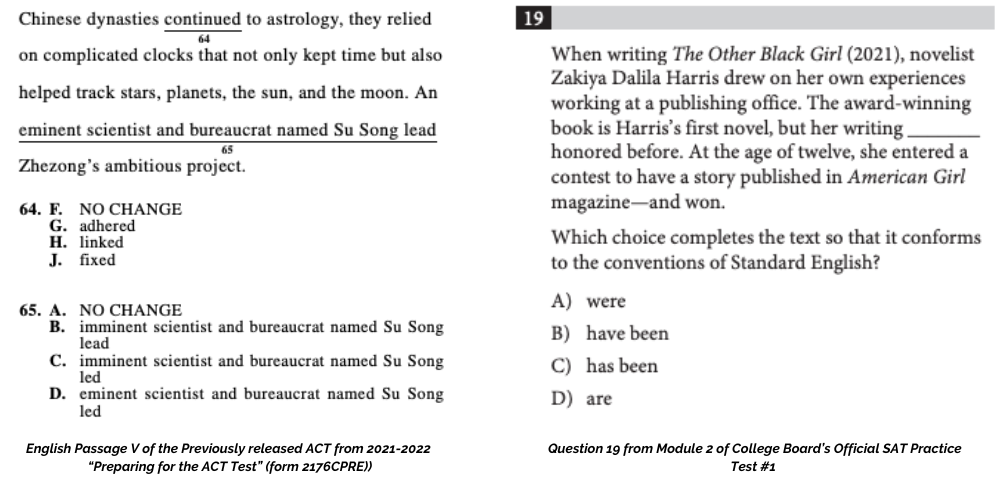
Further, compared to the SAT, the ACT’s English section more frequently tests students on their comprehension of an entire passage. For instance, the set of questions associated with a passage will frequently end with a question like this:
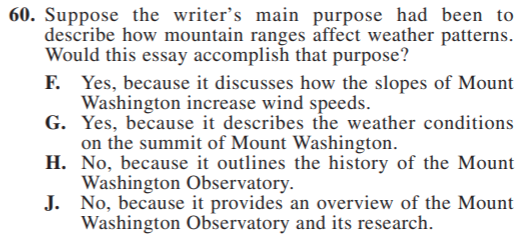
These questions about the “passage as a whole” do not have a direct equivalent on the SAT; it no longer tests similar skills by, for instance, asking about the effectiveness of a given introductory or concluding sentence. In fact, the only types of question on the SAT that tests students on their abilities with text structure and cohesion are about transition words and rhetorical synthesis.
 The rhetorical synthesis questions on the Digital SAT require students to read several bulletpoints of information about a topic, then draw a conclusion based on the most relevant information. The image to the right is an example of this kind of question, also from College Board’s Official SAT Practice Test #1.
The rhetorical synthesis questions on the Digital SAT require students to read several bulletpoints of information about a topic, then draw a conclusion based on the most relevant information. The image to the right is an example of this kind of question, also from College Board’s Official SAT Practice Test #1.
Save for the differences above, the ACT and SAT test you on nearly the same English/Writing topics. For most students, any preference between Digital SAT English questions and ACT English will come down to whether they’d rather read a higher quantity of short passages or six long passages, as well as their level of comfort with answering questions about grammar and style quickly and efficiently.
Summary: ELA on the ACT vs the Digital SAT
At the end of the day, it’s impossible to make a definitive statement about whether the SAT or the ACT is objectively harder for all students based on the content tested on the two exams. That being said, the Digital SAT is designed to be an overall easier experience to take through its smaller question count and shorter ELA passages.
Still, that does not mean that all students will score higher on the Digital SAT, nor that all students will individually find the exam easier. The best way to determine which test will give a student the best opportunity to score well and impress college admissions officers is to try them both out, then compare their performance on each test side-by-side—in addition to their subjective level of comfort with the timing and content.
It’s also worth noting that any preparation a student does for the SAT is not wasted effort in the event that they ultimately decide to shift focus toward the ACT, and vice versa. The skills learned in preparing for one test are highly transferable, so it’s okay to change course midway through the college preparation journey.
The ACT Math Test versus the Digital SAT Math Test
For years, the most significant difference between the SAT and ACT exams was their respective math sections; however, the Digital SAT redesign has made the two standardized, cumulative math tests more alike than ever before. Still, there are some distinctions of note for students deciding which exam to take: timing, question types, and the specific topics/content tested.
Timing of Digital SAT and ACT Math Tests
Digital SAT
ACT
Number of Questions
44
45
Time Allotted
70 minutes
50 minutes
Time per Question
1 minute ~35 seconds
1 minute ~7 seconds
The ACT’s math test requires a much quicker pace than the SAT’s math section. The Digital SAT, with its 44 math questions in 70 minutes total, is split between two 35-minute modules. The ACT consists of one math section of 50 minutes to answer 45 questions.
This averages out to a pace of approximately 1 minute and 35 seconds for each math question on the SAT and about 1 minute and 7 seconds per math question on the ACT. While 30 seconds doesn’t seem like much, consider that this means a student would need to be answering questions at a pace that is approximately 50% faster on the ACT as compared to the SAT.
ACT vs. SAT Math Question Types
The formatting of each exam’s questions directly influences the test-taking experience. Generally, the ACT has always been straightforward when it comes to wording math problems, while the SAT used to present its math questions in a more confusing way. Now, the questions on the Digital SAT’s new math section are far less verbose—one of the primary benefits of the College Board’s renovated exam is that it’s easier to take, so the SAT Math questions are now shorter and more straightforward.
It’s an important skill for students to apply their math knowledge in real-world scenarios, so the ACT and SAT both ask a certain amount of “word problems”: about 30% of Digital SAT Math questions are “set in context”, and the ACT has a similar proportion of “Modeling” questions, which set mathematical topics in real-life problems (often using figures or diagrams).
While the ACT and Digital SAT Math tests present problems in a fairly similar way, they differ when it comes to the way students must answer: All ACT Math questions are multiple-choice between four answer options. Approximately 75% of SAT Math questions are multiple-choice between four answer options, while about 25% are student-produced-response (SPR) questions. The SPR format means that each student will generate their own response and input it into a field by the question—basically, a digitized version of the “bubble in the number” scantron questions of the past.
Math Topics Tested on ACT vs. SAT
While there is plenty of overlap in the content tested on these Math exams, the ACT and Digital SAT each have their own way of designating the importance of key math topics students should know to be prepared for college.
Digital SAT Math Topics
Content Domain
Question Distribution
Topics Being Tested
Algebra
13–15 questions (~35%)
Linear equations, linear functions, systems of equations, linear inequalities, etc.
Advanced Math
13–15 questions (~35%)
Equivalent expressions, nonlinear equations, nonlinear functions, etc.
Problem-Solving and Data Analysis
5–7 questions (~15%)
Ratios, proportions, percentages, probability, scatterplots/models, experiments, etc.
Geometry and Trigonometry
5–7 questions (~15%)
Area and volume, lines and angles, triangles and circles, etc.
ACT Math Topics
Content Category
Question Distribution
Topics Being Tested
Number & Quantity
10–12%
Real and complex number systems, integer and rational exponents, vectors and matrices, etc.
Algebra
17–20%
Linear and polynomial equations, radical and exponential relationships. Finding solutions to systems of equations.
Functions
17–20%
Function definition, notation, representation, and application. Linear, radical, piecewise, polynomial, and logarithmic functions.
Geometry
17–20%
Shapes and solids, triangles, circles, trigonometric ratios, etc.
Statistics & Probability
12–15%
Data collection methods, probabilities, bivariate data.
Integrating Essential Skills
20%
A category that measures how well students apply skills to more complex problems. Rates and percentages, proportional relationships, surface area and volume, average and median
As you can see, both the SAT and ACT have a strong emphasis on fundamental topics in Algebra (linear equations, functions) as well as Geometry (area and volume, angles and triangles, circles). Both tests also integrate questions about ratios, proportions, and percentages.
In addition to the Quantitative Evidence questions found on the Digital SAT Reading & English test, the SAT Math test uses data representation questions and problems about experiments that emphasize reading data/charts to incorporate science problems (in lieu of an SAT Science test).
While the content tested on the Digital SAT leans more into Algebra II, the math topics on the ACT stretch further into Pre-Calculus and Trigonometry. The ACT also has a dedicated category for more complex problems that ask students to combine skills from various content areas in order to solve problems. The ACT has always been known to test higher level concepts than the SAT, and this trend persists with this new SAT format.
Examples of circumference on a coordinate plane questions from the ACT (Question 34 on Preparing for the ACT Test 2023-2023) and the Digital SAT (Question 23 from Module 2 of the The SAT Practice Test #1)
Summary: Math on the ACT vs the Digital SAT
Generally, the ACT has the harder math test. Allowing only a minute per question, the ACT Math requires students to have a greater understanding of higher-level math and to have the capability to solve more complex, multi-step problems. If a student has solid fundamentals in Algebra through the first semester of Algebra II, the Digital SAT may be a better choice; a student with experience in Pre-Calc and Trig could be more suited to the ACT.
Ultimately, each student must decide for themselves which test is right for them and take practice tests for both the ACT and SAT before dedicating significant time to one test.
ACT Writing
Both the SAT and ACT used to come along with an optional (but strongly recommended) written component: the SAT Essay and the ACT Writing Test. However, the SAT removed the essay entirely in the Summer of 2021—now, only the ACT has an optional essay portion.
Gets detailed tips and strategies for the ACT Writing test in this separate how-to guide.
The ACT Writing Test Overview
The ACT asks students to craft an argument in the form of an argumentative essay about a particular topic. They have 40 minutes to write the essay. The test always begins with a brief description of an issue of wide relevance to modern society, like this one:

After that, the test presents a set of three possible perspectives on that issue:
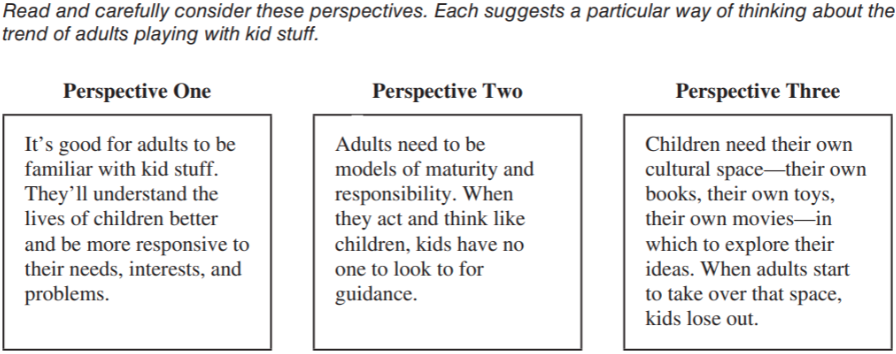
Finally, the test presents students with their writing task:
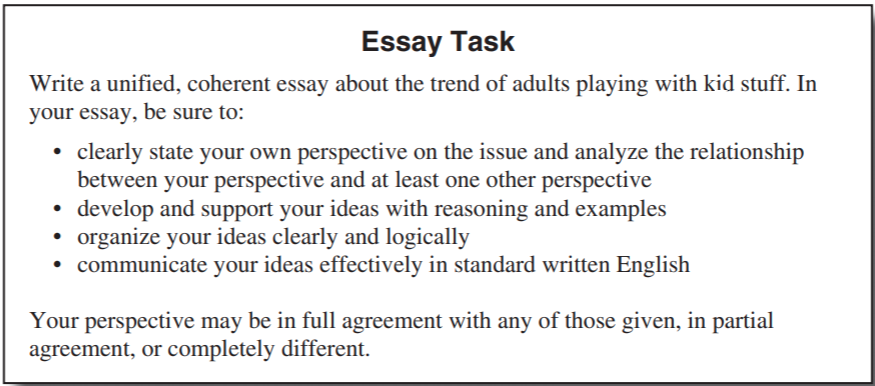
This argumentative writing task is always the same; the only portion of the prompt that the ACT changes for each test is the phrase that comes after “Write a unified, coherent essay about . . .”
How the ACT Writing Test is Scored
On the ACT, two different readers give each essay a score between 1 and 6 in each of four “domains”: Ideas & Analysis, Development & Support, Organization, and Language Use & Conventions. The two readers’ scores are added together, resulting in a total score between 2 and 12 in each dimension.
In addition to individual domain scores, the ACT reports a “subject-level score” for the Writing Test as a whole, which is the rounded average of a student’s domain scores.
More importantly, though, a student’s scores for the ACT’s Writing Test is kept completely separate from their scores on the rest of the test; the essay component does not factor into the ACT’s composite score out of 36.
If you’re a strong writer who wants to showcase your skills, make sure to sign up for the ACT to take advantage of its optional essay section!
How to Prepare for the ACT and the new Digital SAT
The most vital differences between ACT and SAT exams are that (1) the SAT is fully digital, (2) only the ACT has a Science section and an Essay, and (3) the ACT requires a much faster pace, though the SAT is technically longer (excluding the ACT’s Science section) and has some more complex questions. While we encourage that you take both exams, we hope that this article helped you decide which test to invest more time and effort into preparing for.
As you begin or continue your test prep journey, Piqosity is here to help! Along with our full-length, online ELA and Math courses for grades 6-11, we offer full SAT, ACT, and ISEE test prep courses, each of which includes 12 practice exams, dozens of concept lessons, personalized practice software, and more.
The best part? You can try out all of Piqosity’s features with our free community account. When you’re ready to upgrade, Piqosity’s year-long accounts start at only $89.
More Educational Resources by Piqosity:


